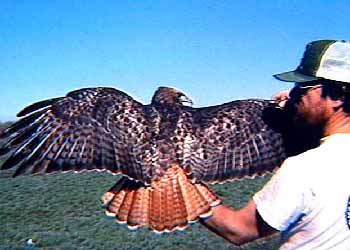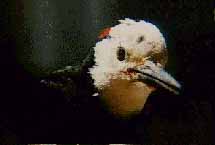|
|

© copyright 2003 Michael P.
Hamilton, Ph.D.
Norm's birds

August 20, 1996:
Norm Hogg passed away last night, and I find myself
flooded with a thousand vivid memories of condor watching on Mt.
Pinos, story telling around campfires, hooting for spotted owls,
and banding song birds. I met Norm my freshman year at Cal Poly,
and he was one of those awesome graduate students who seemed to
know everything about the field sciences. Norm and I shared the
identical set of crazed professors at Pomona who infected us with
the dreaded "field biologist virus." With our professors
and fellow students we were compelled to camp and explore all the
nooks and crannies of southern California during an era when there
was half the resident population as today. It was great. In order
for students like us to remain in field biology we must become deeply
ingrained in the spirit of our purpose to study life, and for me
that could not have happened unless I was around kindred souls,
like Norm.

White-headed Woodpecker
My mind rewinds through this rich landscape of memories,
recounting one biological adventure after another. Every year since
I have been in charge of the James Reserve, Norm has brought up his
field zoology class from Santa Monica College over the Memorial Day
weekend. During four days, students learn the fine art of rodent trapping
and lizard noosing, and the proper uses of mist nets and kill jars.
One year, two birds caught in our mist net were wriggling to escape,
but with each movement they became further tangled in the filamentous
black web they could not see, but definitely feel. Looking through binoculars,
we noted the sky blue iridescence that characterizes the feathers of
a female western bluebird. The other bird was completely black, except
for the bright red spot on the back of its head, and white cheeks. We
were trapping birds to catalog them by their species, sex, and weight,
and before releasing them, to place a series of unique numbered bands
on their legs to identify each individual the next time it was captured.
Over the years we have learned a lot about the local birds
because of this effort. While I was helping one of the students remove
the bluebird from the net, Norm let out a loud cry as the white-headed
woodpecker he was holding attempted to drill a hole into the side of
his hand! It struck us as funny to watch the little red-headed bird
working on his hand at a rate of about ten pecks per second, and yet
there was nothing Norm could do but continue to remove it slowly it
from the mist net.
About twenty years ago, one of our mutual Cal Poly professors,
Tim Brown, died at a young age of a heart attack while collecting bats
on Santa Cruz Island. Tim without doubt had the most influence on Norm,
and I, in our decisions to become field biologists. He introduced both
of us to Harry James and his beautiful home and Reserve behind Lake
Fulmor during an ecology field trip. Norm and I have recalled Tim's
passing on numerous occasions over the years, remarked upon the profound
effect Tim had on our lives, and wondered where he would be today if
he still lived. I think Tim would be doing exactly what Norm has been
doing, teaching young people about science, taking them far and wide
to experience the natural world first hand, and setting an example of
being so connected to natural science that it permeates nearly every
aspect of his life. I don't feel that a day will pass over the rest
of my life, when I will see a western bluebird and not think about Norm,
and all of Norm's birds. May the peace of the wilderness be with you
Norm.

previous journal entries
|

